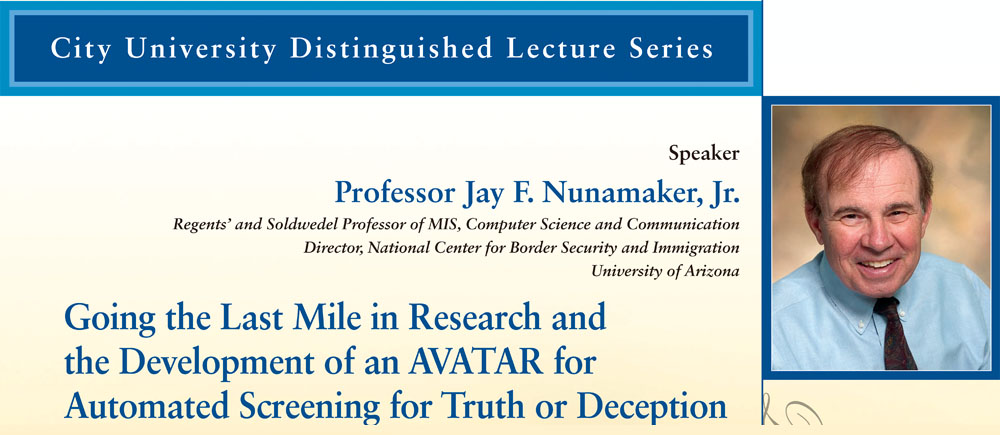
| Date: | 04 October 2011 |
|---|---|
| Speaker: | Prof. Jay F Nunamaker. Jr. |
This talk will cover two topics: (1) Going the last mile in research to create high visibility and impact and (2) Deception detection with an AVATAR.
A new framework will be presented for guiding one through the last mile. At conferences, we see many papers presented that amount to the following: I was sitting at my desk when I got this great idea. I published a paper on the idea and dusted-off my hands in satisfaction. My work is done and transition to the workplace is merely details. Such ideas, though, are a dime a dozen. Little credit is therefore warranted for conceiving an idea. Full marks are due, however, for shepherding an idea through the last mile, from inspiration to implementation in the workplace. The last mile means using knowledge to solve real problems for people with a stake in the outcome. As researchers in knowledge management, group support systems, and deception detection can attest, the last mile can be a long and winding road. However, it is a road worth traveling, for the good of the researcher and for the good of the society. It leads through scientific discovery that can yield exciting exploratory, theoretical, experimental and engineering contributions.
In this talk we will also introduce a multi-disciplinary deception detection model consisting of automated methods for detecting linguistic, vocalic, kinesic and psychometric cues. We have developed automated tools for behavioral and psychometric analysis with the end goal being a system that recommends individuals for further scrutiny. Our approach is designed to track and identify body and facial movements, behavioral patterns and psychometric cues such as heart rate, eye gaze, pupilometry, blink rate and temperature change around the eyes, nose and mouth. A prototype decision support system to assist humans distinguish truth-tellers from liars is being developed and tested in the laboratory and the field. It consists of an artificial intelligence agent embedded in an AVATAR and is packaged in a kiosk. The AVATAR is being developed to conduct primary and secondary screening of individuals at ports of entry, including border crossings and airports. It can also be deployed in a variety of border security and immigration scenarios such as personnel screening for new agents and visa processing. This technology has promise for detection of deception in job interviewing, resume evaluating and financial reporting in addition to securing the borders.
Professor Jay F. Nunamaker, Jr. is Regents and Soldwedel Professor of MIS, Computer Science and Communication. He is Director of the Center for the Management of Information and the National Center for Border Security and Immigration at the University of Arizona.
Professor Nunamaker was inducted into the Design Science Hall of Fame, May 2008. He received the LEO Award for Lifetime Achievement from the Association of Information Systems (AIS) at the International Conference on Information Systems (ICIS) in Barcelona, Spain, December 2002. He was elected a fellow of the AIS in 2000. He was featured in the July 1997 Forbes Magazine issue on technology as one of eight key innovators in information technology. He is widely published with an H index of 53 in the fields of collaboration technology and deception detection. He was a research assistant funded by the Information System Design and Optimization System (ISDOS) project in industrial engineering at the University of Michigan and an Associate Professor of Computer Science at Purdue University. Professor Nunamaker received his Ph.D. in operations research and systems engineering from Case Institute of Technology, an M.S. and B.S. in engineering from the University of Pittsburgh, and a B.S. from Carnegie Mellon University. He received his professional engineer’s license in 1965.